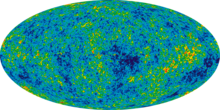ylem
English[edit]


Etymology[edit]
Resuscitation of Middle English ylem, from Medieval Latin hȳlem, accusative of hȳlē (“matter, the fundamental matter of all things; the matter of the body”) (whence English hyle), a transliteration of Ancient Greek ὕλη (húlē, “wood; material, substance; matter”). The concept of “fundamental matter” – Ancient Greek πρώτη ὕλη (prṓtē húlē) – was propounded by the Greek philosopher Aristotle (384–322 B.C.E.).
The term ylem was first used in modern English in the paper “The Origin of Chemical Elements”, coauthored by Russian-American theoretical physicist and cosmologist George Gamow (1904–1968), American cosmologist Ralph Asher Alpher (1921–2007) and German-American nuclear physicist Hans Bethe (1906–2005), published 1 April 1948 in Physical Review.[1] Alpher claimed to have found the word “in a large dictionary”,[2] perhaps Webster’s New International Dictionary (2nd ed., 1934), which he referred to in a second 1948 paper (cited below). In a 1968 interview, Gamow also associated ylem with a Hebrew word he did not name;[3] it remains unclear which word he was referring to.
The word ylem reappeared in popular books on science following the discovery in 1964–1965 of the cosmic microwave background, which had been predicted in 1948 by Alpher and Robert Herman (1914–1997),[4] and again after the publication of images of the radiation composed from measurements by two satellites, the Cosmic Background Explorer (COBE) in 1992 and the Wilkinson Microwave Anisotropy Probe (WMAP) in 2003.
Pronunciation[edit]
Noun[edit]
ylem (uncountable)
- (cosmology, now chiefly historical) In the Big Bang theory, the hot and dense plasma that made up the matter in the cosmos following the initial baryogenesis at an early stage of its expansion and cooling, from which the first atoms formed and photons decoupled. The emission of photons in this phase is regarded as the source of the cosmic microwave background. [from 1948.]
- 1948 December 1, R[alph] A[sher] Alpher, “A Neutron-capture Theory of the Formation and Relative Abundance of the Elements”, in Physical Review, volume 74, number 11, College Park, Md.: American Physical Society, , →OCLC, page 1581, column 1:
- Very shortly after the beginning of the universal expansion, the ylem was a gas of neutrons only. [Footnote: According to Webster's New International Dictionary, 2nd Ed., the word ‘ylem’ is an obsolete noun meaning ‘The primordial substance from which the elements were formed.’ It seems highly desirable that a word of so appropriate a meaning be resurrected.]
- 1952, George Gamow, The Creation of the Universe, New York, N.Y.: Viking Press, OCLC 999160; republished as New York, N.Y.: Viking Press, 1961, 2nd edition, OCLC 642243549, page 53:
- Let us now consider the state of matter during the first minutes of the expansion process, when the temperature of the universe was many billions of degrees high. […] [T]he state of matter must be visualized as a hot gas formed entirely by nuclear particles; that is, protons, neutrons, and electrons. […] We will call this primordial mixture of nuclear particles "Ylem," [footnote: Pronounced: ī′lěm] reviving an obsolete noun which, according to Webster's Dictionary, means "the first substance from which the elements were supposed to be formed." Next we can ask what happened to the Ylem when its density and temperature began to drop as the result of the rapid expansion taking place in the young universe.
- 1959, James Blish, chapter 7, in A Clash of Cymbals [US title: The Triumph of Time] (Cities in Flight; 4), London: Faber and Faber, →ISBN, page 171:
- The ylem was the primordial flux of neutrons out of which all else emerged.
- 2008, Piers Bizony, “Part Eight, Ylem”, in Atom, Thriplow, Cambridgeshire: Icon, →ISBN, page 171:
- He [George Gamow] surmised that that the universe began as a super-condensed raging inferno of protons, neutrons and electrons, which he and his colleagues called the ylem […] The internal pressures of the ylem caused it to expand outward extremely rapidly. After a few minutes the ylem cooled down sufficiently to allow the strong force to bind neutrons and protons together into deuterium nuclei. […] Then there was just enough time for some of the deuterium to fuse into helium before temperatures and pressures of the ylem became too diffuse to allow more fusions.
References[edit]
- ^ R[alph] A[sher] Alpher, H[ans] Bethe, G[eorge] Gamow (1948 April 1) “The Origin of Chemical Elements”, in Physical Review, volume 73, number 7, College Park, Md.: American Physical Society, , →OCLC, page 803.
- ^ Ralph A[sher] Alpher, Robert Herman (2001) Genesis of the Big Bang, New York, N.Y.: Oxford University Press, →ISBN, page 2.
- ^ George Gamow, Charles Weiner, interviewer (1968 April 25) “Oral Histories: George Gamow”, in Niels Bohr Library & Archives, American Institute of Physics[1], archived from the original on 2 June 2016:
- Gamow: You can look in the Webster dictionary. This is a word—I think it’s an old Hebrew word, but Aristotle was using it—in Webster dictionary it says “material from which elements were formed.” / Weiner: The primordial substance? / Gamow: The primordial substance, yes—ylem. […] I mean this is the old Hebrew word meaning something like “space between heaven and earth.”
- ^ R[alph] A[sher] Alpher, R[obert] C. Herman (1948 December 15) “On the Relative Abundance of the Elements”, in Physical Review, volume 74, number 12, College Park, Md.: American Physical Society, , →OCLC, pages 1737–1742.
Further reading[edit]
Anagrams[edit]
Middle English[edit]
Noun[edit]
ylem (uncountable)
- Alternative form of yle.
- English terms inherited from Middle English
- English terms derived from Middle English
- English terms derived from Medieval Latin
- English doublets
- English terms derived from Ancient Greek
- English 2-syllable words
- English terms with IPA pronunciation
- English terms with audio links
- English lemmas
- English nouns
- English uncountable nouns
- en:Cosmology
- English terms with historical senses
- English terms with quotations
- en:Obsolete scientific theories
- Middle English lemmas
- Middle English nouns
- Middle English uncountable nouns